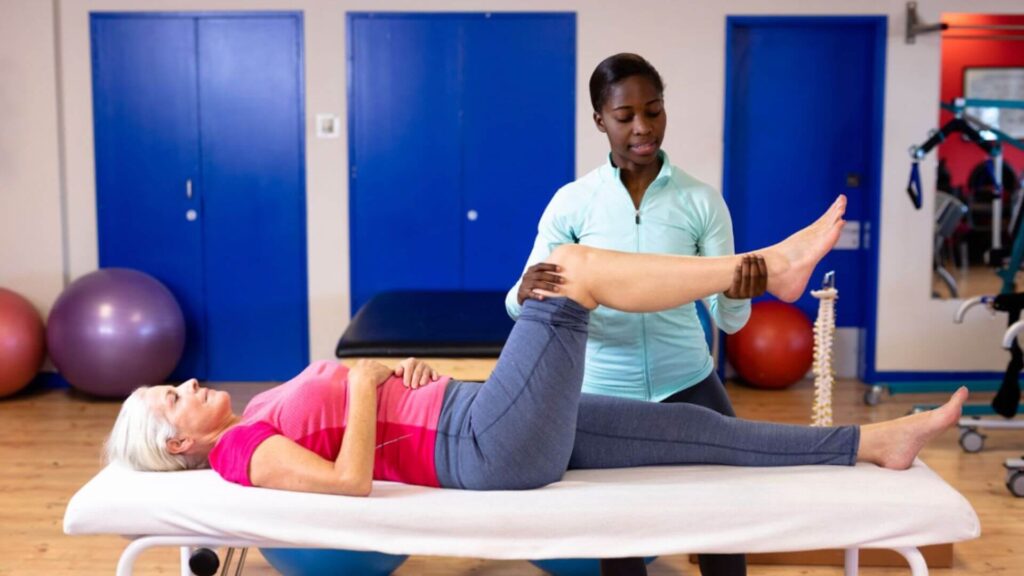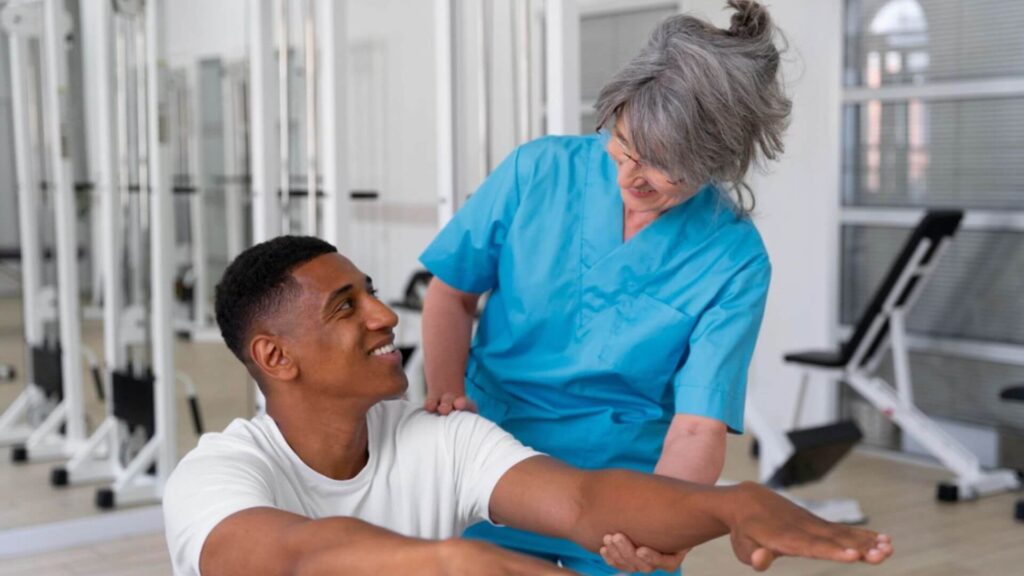Therapeutic Exercise Programs
Therapeutic exercise is one of the methods physical therapists frequently employ for patient rehabilitation. This exercise helps improve deficits, decrease pain, and increase flexibility by restoring skeletal and muscle function. To treat your musculoskeletal problems, your physical therapist might have extra goals for therapeutic exercise. Therapeutic exercise programs can be recommended for several illnesses, such as joint or body part ailments, common orthopedic injuries, postoperative care, and sports injury recovery.

With its expertise and tools, Motion Physical Therapy can design a therapeutic exercise program to help you recover. Although you might believe surgery is necessary for your injury, this isn’t always true. In addition to relieving pain, strengthening the injured area can help avoid further injuries. If you have been injured recently and want to explore a therapeutic exercise program as an option, please get in touch with us to answer any of your questions or book an appointment.
The Types of Therapeutic Exercise
Physical therapists recommend a variety of rehabilitative exercise regimens for their patients; in this article, we’ll examine four. Programs are customized for your unique situation and may be changed by your degree of general physical health. Early in your recovery, a physical therapist might devise a reduced plan; as your condition improves, they might add new components. If your physical therapist suggests therapeutic exercise as part of your treatment plan, you will know what to expect. Here are some types of therapeutic exercise programs:
Strengthening
Activities that increase muscle tissue in the targeted areas are called strength training. Muscles can deteriorate extremely fast after an injury or surgery. In addition to causing muscles to contract or become “inhibited,” pain can also result in weakness.
Exercises for strengthening the muscles can vary significantly in intensity based on the patient’s degree of fitness and present state of recovery. Resistance training, which includes using weights, bands, or body weight to increase and develop muscle strength, is another name for strengthening exercises.
Endurance
Endurance exercises are done for extended periods and incorporate more extensive total muscle motions. Due to the patient’s low physical capacity, endurance might not be included in the first therapeutic exercise program; however, if the patient gets more robust and can handle more significant activity, it might be incorporated later.
If your physical therapist prescribes endurance exercises as part of your program, you can perform them at home. Low-impact aerobics, walking, swimming, and using the stairs rather than the elevator are a few forms of endurance training. Endurance activities also improve the cardiovascular system.
Balance and Coordination
Rehabilitation often involves challenges with physical coordination due to weakened muscles in the affected area. In addition to strengthening the muscles, therapeutic exercises can improve their ability to cooperate. A body part can act more coordinated, and the more well-functioning muscles work as a team, enhancing movement and lowering the chance of re-injury—exercises for balance and coordination work hand in hand to improve joint stability and posture.
Balance exercises can be as easy as briefly balancing on one foot or using equipment like an exercise ball. Your physical therapist might also suggest beginning yoga to enhance balance and coordination. This kind of exercise is also called neuromuscular re-education because it directly modifies the relationships between the neurological and muscular systems.

Flexibility
It can be challenging to stretch if your muscles or joints are stiff. Exercises for flexibility can help you increase your range of motion and relax your muscles. Because they involve slow, deliberate motions done in brief bursts, these therapeutic exercises are regarded as low intensity. Since stretching muscles while they are warm is preferable, flexibility exercises are typically performed as the final exercise during a physical therapy session.
The Benefits of Therapeutic Exercise
Therapeutic exercise offers several advantages, and our staff has years of experience incorporating this strategy into successful treatment regimens. Here are a few of the benefits that therapeutic exercise can offer patients:
Joint Function
Stronger muscles help support the body’s weight and joints. It is especially beneficial for people with joint issues such as osteoarthritis, where cartilage degeneration at the ends of bones causes excruciating pain and friction.
Therapeutic exercise also causes an increase in synovial fluid—the fluid that lubricates joints—entering the space between mobile joints to lessen friction during movement. Weak and lax soft tissues can also cause chronic pain and joint dysfunction that restricts movement. To better support these joints and relieve some additional stress, strengthening supporting muscles through therapeutic exercise may even alleviate pain. It is particularly true when prolotherapy—which can help heal damaged soft tissues, stabilize joints, and relieve pain—is used with therapeutic exercise.
Increased Wellness and Fitness Levels
Regardless of the cause behind your physical therapy visit, therapeutic exercise provides a comprehensive method of alleviation. Exercise may address an ailment, but it can also benefit your general health, which includes your heart and lungs.
Exercises targeting respiratory muscles improve breathing efficiency and strengthen these muscles. According to the American Lung Association (Exercise and Lung Health, n.d.), exercise increases the body’s efficiency in delivering oxygen to the blood and other parts of the body; because of this, exercise—especially therapeutic exercise—is essential for heart and lung health.

A Stronger Body
A therapeutic exercise program is needed to increase your body’s overall strength, enhance your posture, and enable you to carry out daily activities more efficiently.
When you exercise, the body naturally produces endorphins, a neurotransmitter that functions as a painkiller. Additionally, endocannabinoids, another type of neurotransmitter, are released, which aid in calming the individual. Exercise can assist in removing extra fluid from various body areas and reintroducing it into the body’s circulation. Removing excess liquid and reintroducing it to the body’s circulation might help relieve chronic pain accompanied by inflammation and fluid accumulation. Sometimes, the pain might be reduced by eliminating this extra fluid pressing on the receptor ends.
Metabolism
Exercise increases insulin sensitivity, influencing how cells absorb and use sugar, ultimately controlling blood sugar levels. Skeletal muscles also use many fatty acids, lowering blood cholesterol and improving cardiovascular health to support mechanical function. Since they use much energy to move, skeletal muscle burns more calories and helps prevent excessive weight gain.
Muscle Strength
Therapeutic exercise can strengthen previously weak muscles due to injury, illness, or advanced age. A person with solid muscles is better able to carry out daily tasks, restore previously compromised mobility, and maintain independence as they age. Strong muscles also maintain healthy, robust bones and a strong skeleton.

Frequently Asked Questions
What Is a Therapeutic Exercise?
Therapeutic exercise is a recommended physical activity tailored to individual requirements and capabilities. Its main objectives are promoting long-term health and well-being, reducing pain, and restoring physiological function. Therapeutic exercises are highly focused motions created for a specific goal, as opposed to general workouts like weightlifting or running.
What Is the Difference between Physical Therapy and Therapeutic Exercise?
The difference between physical therapy and therapeutic exercise is that physical therapy is a medical specialty that aims to help patients with various ailments maintain, enhance, or regain their physical function. Therapeutic exercise is a unique form of physical therapy that focuses on targeted motions and exercises to meet specific medical requirements and promote healing. A therapeutic exercise program is a particular treatment within the broader field of physical therapy.
What Are the Goals of Therapeutic Exercise?
The goal of therapeutic exercise is to enhance your general physical function and well-being. This goal can be divided into several smaller goals geared toward encouraging the best possible health and avoiding accidents. Among these goals are:
- To correct impairments
A person may become impaired for several reasons, including disease or trauma. For instance, a strained muscle may result in pain and limited range of motion. Therapeutic activities can aid in the healing process and restore normal function, which can help address specific deficiencies.
- To regain muscle function
- Enhance skeletal performance
- Maintaining stability, movement, balance, and coordination requires healthy skeletal function. For instance, if you suffer a fracture, it could take longer for your bones to mend and become stronger. Therapeutic exercises can help improve skeletal function by stimulating bone growth and strengthening the surrounding muscles.
- Prevent injuries
- Promote long-term health
Is Stretching a Therapeutic Exercise?
Stretching can be considered therapeutic if performed correctly and under a doctor’s supervision. It can lessen muscle soreness and tension, increase range of motion, and enhance general bodily function.
Therapeutic Exercise Program Therapists in Bogota, NJ
Motion Physical Therapy has therapeutic exercise program therapists in Bogota, NJ. We know how musculoskeletal pain or injury can prevent you from engaging in everyday activities. We provide tailored care plans that include therapeutic exercise programs to assist you in getting back on your feet. Make an appointment for physical therapy with us now, and find out if therapeutic exercise suits you.
Bibliography
Association, American Lung. “Exercise and Lung Health.” American Lung Association, www.lung.org/lung-health-diseases/wellness/exercise-and-lung-health. Accessed 25 Mar. 2024.
Our Services
- Orthopedic RehabilitationOrthopedic Rehabilitation
- Post-Surgical RehabilitationPost-Surgical Rehabilitation
- Sports Injury RehabilitationSports Injury Rehabilitation
- Geriatric RehabilitationGeriatric Rehabilitation
- Injury PreventionInjury Prevention
- Therapeutic ExerciseTherapeutic Exercise
- Manual TherapyManual Therapy
- Telehealth ServicesTelehealth Services
- Postural AssessmentPostural Assessment
- Balance RehabilitationBalance Rehabilitation

